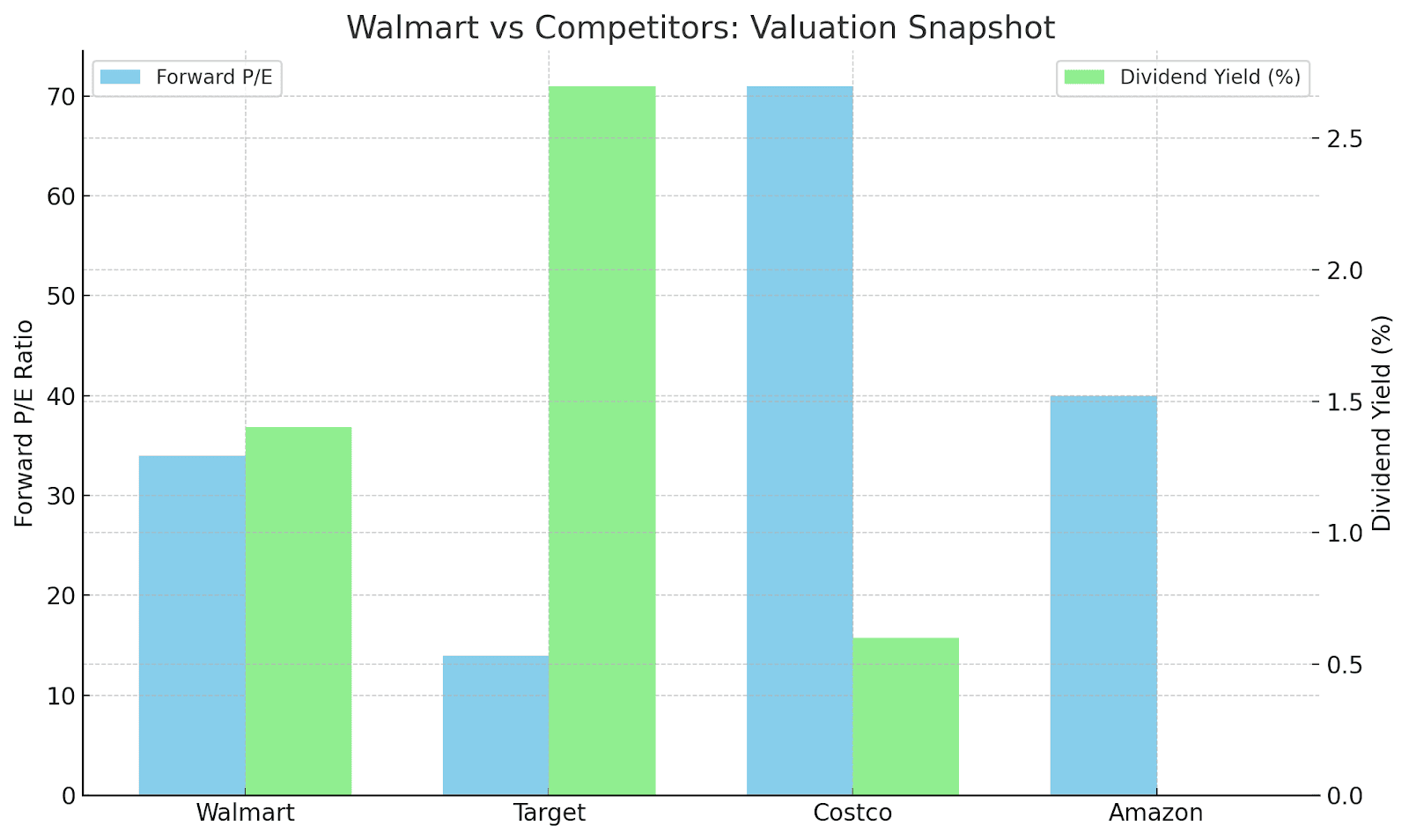Walmart ($WMT) is often included in conversations about defensive stocks, but its role goes beyond just providing downside protection. It serves as a signal—an indicator that when consumers begin to pull back, capital tends to rotate into companies that don’t just endure downturns, but benefit from them.
While the Federal Reserve is expected to conclude quantitative tightening in the coming months, inflation remains above the 2% target, and new tariffs are raising the risk of stagflation. Liquidity conditions may be easing, but early signs of pressure are emerging across both consumers and corporates. That makes now a critical time to look at names that can hold ground—and quietly gain strength—when others falter.
Financial Position
In fiscal year 2025, Walmart reported:
- Total revenue: $681 billion, up 4.1% year over year
- Q4 revenue: $180.6 billion
- U.S. comparable sales: +4.6% (excluding fuel)
- U.S. e-commerce growth: +20%
- Global e-commerce growth: +16%
- Operating income: +8.3% (adjusted: +9.4% constant currency)
E-commerce is now a $100 billion-plus channel for Walmart, and membership services like Walmart+ are growing. Its physical footprint remains a core strength, but the digital layer is now deeply embedded in how the business scales.
What’s compelling isn’t just top-line growth—it’s the diversification of the customer base. Higher-income households are increasingly shopping at Walmart, shifting behavior in response to macro pressures. Walmart isn’t just retaining its base—it’s expanding it.
Walmart also returned over $10 billion in share buybacks in fiscal 2025 and continues to increase its dividend, with over 50 consecutive years of growth. Its current dividend yield is approximately 1.4 percent.
Resilience Through Cycles
Walmart’s performance during past economic downturns tells a clear story:
- During the 2008–2009 financial crisis, while the S&P 500 dropped nearly 40 percent, Walmart gained over 12 percent from early 2008 through the end of 2009.
- During the initial wave of the COVID-19 recession in 2020, Walmart scaled its logistics infrastructure and reported a 97 percent year-over-year increase in U.S. e-commerce sales in Q2.
- In the 2023 inflationary environment, Walmart attracted higher-income shoppers as inflation weighed on household budgets. It outperformed many of its retail peers during this period.
These examples show a repeatable pattern: when consumers reprioritize spending, Walmart does not just defend its ground—it gains market share.
Behavioral Advantage
Walmart’s ($WMT) edge in recessions isn’t just economic—it’s behavioral.
Consumers under pressure shift toward consistency and control. Walmart provides that through affordability, availability, and simplicity. Once customers switch in a downturn, many remain afterward. Value-based habits become normalized, particularly when the overall experience still meets expectations.
This results in a customer retention loop driven more by psychology than by advertising. As middle- and higher-income consumers adopt more cost-conscious behavior, Walmart becomes the default—rather than the fallback.
Valuation
As of April 2025:
- Stock price: approximately $87.26
- Forward P/E: approximately 34x earnings
- Dividend yield: approximately 1.4%
Walmart currently trades above its five-year historical average forward P/E of around 24x. It trades at a higher multiple than Target (approximately 14x), but significantly lower than Costco (approximately 71x) and Amazon (approximately 40x). This reflects the market’s recognition of Walmart’s stability, scalability, and improving margins.
Over 70 percent of Wall Street analysts rate Walmart a “Buy” or “Overweight,” with the remainder mostly holding “Neutral” positions. No major institutions currently rate it a “Sell.”
To put this into perspective, here is how Walmart compares to key retail peers:

Source: Chart created internally using data from Yahoo Finance, GuruFocus, and public company disclosures.
Competitive Edge
Walmart’s real advantage lies in its integration of online and offline operations.
With over 4,700 stores in the United States that double as fulfillment hubs, Walmart has built a hybrid model that supports rapid local delivery, efficient store pickup, and lower last-mile costs. While Amazon continues to lead in pure e-commerce, Walmart has built a competitive edge in essential categories such as groceries and household items—areas where delivery costs can erode margins.
Unlike Target, which leans on branding and discretionary appeal, Walmart dominates in non-discretionary essentials. Its footprint is broader and more accessible than Costco, which operates a membership model.
Walmart also continues to refine its global presence. It has exited lower-performing markets such as the United Kingdom and Argentina, while strengthening its operations in high-growth regions such as Mexico, India (through Flipkart), and Chile. This more focused global strategy supports profitability and simplicity.
Tech and Automation
Walmart has evolved into one of the most operationally advanced retailers through significant investment in automation and artificial intelligence.
- Robotic systems deployed through Symbotic are reducing warehouse processing times and labor costs.
- AI is being used for dynamic pricing, inventory forecasting, and personalized product recommendations.
- In-app shopping features and smart delivery scheduling are streamlining the customer journey.
Walmart also has committed to reaching net-zero emissions by 2040. The company is investing in renewable energy, supply chain transparency, and other ESG-focused initiatives—positioning it well with institutional and sustainability-conscious investors.
Risks
No investment is without trade-offs.
Walmart’s margins are thin by design. This makes the company more vulnerable to cost pressures if inflation intensifies again. Amazon remains a long-term threat, particularly as it continues to push into grocery and essential categories. Furthermore, Walmart’s automation strategy, while efficient, may draw criticism over labor reductions and regulatory concerns.
However, these risks are broadly understood by the market and do not significantly challenge Walmart’s long-term thesis.
Other Growth Avenues
Walmart is not just defending its core business—it is expanding into high-margin adjacent verticals.
- Walmart+ continues to gain traction, offering an ecosystem that drives repeat engagement.
- The company’s retail media business—selling ad space on Walmart’s digital channels—generates increasingly significant revenue at high margins.
- Walmart is also exploring health care and financial services, from in-store clinics to digital banking and insurance tools.
These initiatives are still developing, but they offer meaningful future optionality.
Conclusion
Walmart is not a momentum stock. It is a conviction position—tailored for portfolios that prioritize resilience, visibility, and long-term relevance.
It protects capital during downturns, captures market share during behavioral shifts, and adapts through strategic innovation. Its foundation is built on consistent performance, operational excellence, and customer loyalty.
Walmart is “boring” but brilliant. And in the current economic environment, boring is exactly what works.
This communication is for information and education purposes only and should not be taken as investment advice, a personal recommendation, or an offer of, or solicitation to buy or sell, any financial instruments. This material has been prepared without taking into account any particular recipient’s investment objectives or financial situation and has not been prepared in accordance with the legal and regulatory requirements to promote independent research. Any references to past or future performance of a financial instrument, index or a packaged investment product are not, and should not be taken as, a reliable indicator of future results. eToro makes no representation and assumes no liability as to the accuracy or completeness of the content of this publication.






